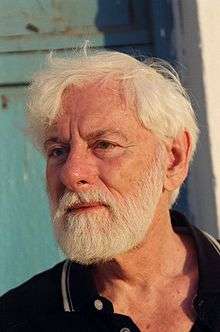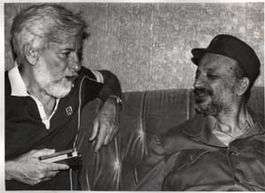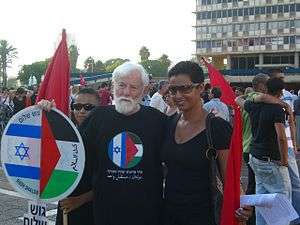Uri Avnery
| Uri Avnery | |
|---|---|
 | |
| Date of birth | 10 September 1923 |
| Place of birth | Beckum, Germany |
| Year of aliyah | 1933 |
| Knessets | 6, 7, 9 |
| Faction represented in Knesset | |
| 1965–1974 | Meri |
| 1979–1981 | Left Camp of Israel |
Uri Avnery (Hebrew: אורי אבנרי, also transliterated Uri Avneri, born 10 September 1923) is an Israeli writer and founder of the Gush Shalom peace movement.
A member of the Irgun as a teenager, Avnery sat in the Knesset from 1965 to 1974 and from 1979 to 1981.[1] He was also the owner of HaOlam HaZeh, an Israeli news magazine, from 1950 until it closed in 1993.
He is famous for crossing the lines during the Siege of Beirut to meet Yassir Arafat on 3 July 1982, the first time the Palestinian leader ever met with an Israeli. Avnery is the author of several books about the Israeli-Palestinian conflict, including 1948: A Soldier’s Tale, the Bloody Road to Jerusalem (2008); Israel’s Vicious Circle (2008); and My Friend, the Enemy (1986).
Biography
Avnery was born in Beckum, Germany, as Helmut Ostermann, to a well-established German Jewish family. Avnery and his family emigrated to Mandatory Palestine in 1933, following Adolf Hitler's rise to power.[2][3] He attended school in Nahalal and then in Tel Aviv, leaving after 7th grade, at age 14, in order to help his parents. He started work as a clerk for a lawyer, a job he held for about five years.
He joined the Irgun, a Zionist paramilitary group, in 1938,[4] but unlike his comrade-in-arms Yitzhak Shamir who joined up at roughly the same time, was judged too young to engage in action,[5] and wrote for some of their internal publications. At one point he edited the internal Revisionist journal Ba-Ma'avak ("in the Struggle").[6] He started writing for independent publications at the age of 17.
He left the Irgun in 1942[4] after becoming disenchanted with their tactics, stating in a 2003 interview that, "I didn't like the methods of terror applied by the Irgun at the time", noting he did not back killing people in retaliation for similar acts by the Arabs.[7] In 1947 Avnery started his own small group, Eretz Yisrael Hatze'ira ("Young Land of Israel"), which published the journal Ma'avak ("Struggle").[4][8] Avnery's early political thought was influenced by Canaanism; in 1947 he proposed a union of the countries in the "Semitic region": Palestine, Transjordan, Lebanon, Syria, and Iraq.[9]
During the 1948 Arab-Israeli War Avnery fought on the southern front in the Givati Brigade as a squad commander, and later in the Samson's Foxes commando unit (and also wrote its anthem).[2][4][10] He wrote dispatches from the front line which were published in Haaretz and later as a book, In the Fields of Philistia (Hebrew: בשדות פלשת, Bi-Sdot Pleshet).[2] Avnery was wounded twice, the second time, toward the end of the war, seriously; he spent the last months of his army service convalescing and was discharged in the summer of 1949.[2]
After briefly working at Haaretz, Avnery (with Shalom Cohen and two others) in 1950 bought the failing magazine HaOlam HaZeh ("This World").[2] Avnery edited the weekly magazine during the 1950s and the 1960s, turning it into an anti-establishment tabloid known for many sensational scoops and for featuring nudes on its back cover. The formula seemed to work, as for many years it was Israel's leading alternative-media publication.
After the Egyptian Revolution of 1952 Avnery used his editorials in HaOlam HaZeh to call for a preventive war against Egypt, arguing that "the reactionary Arab regimes" would attack Israel "the minute Arab superiority in weapons over Israel is great enough."[11] He began to revise his views after the 1956 Suez Crisis, which ended in Israeli withdrawal and strengthened Nasser.[12] In June 1957 Avnery suggested that Israel aid Palestinians in overthrowing the Hashemite monarchy in Jordan (a "product of imperialism"); Israel would then form a federation with the new Palestinian Jordanian state.[12] In the late 1950s Avnery was among the founders of the group Semitic Action, which argued for a regional federation of Israel and its neighbors.[13]
In 1965 Avnery created a political party bearing the name of his and Cohen's magazine, HaOlam HaZeh – Koah Hadash, and was elected to the Knesset in the 1965 election. Although he retained his seat in the 1969 election, the party disintegrated and Avnery renamed it Meri. Although it failed to win any seats in the 1973 elections, Avnery returned to the Knesset as a member of the Left Camp of Israel after the 1977 election, but did not retain his seat in the 1981 election. He was later involved in the Progressive List for Peace.
In late 1975 Avnery was among the founders of the Israeli Council for Israeli-Palestinian Peace.[14] Shortly after the group's founding, Avnery was assaulted and stabbed several times.[15]

Avnery famously crossed the front lines and met Yasser Arafat on 3 July 1982, during the Siege of Beirut — said to have been the first time an Israeli met personally with Arafat.[16]
His visit with Arafat was among the reasons he became estranged from his mother, Hilda Ostermann, who disinherited him. In her will, Hilda wrote "I do not leave a penny to my son Uri, who instead of taking care of me went off to visit that murderer Yasser Arafat".[17]
He later turned to left-wing peace activism and founded the Gush Shalom movement in 1993, which he continues to lead as of 2009. He is a secularist and strongly opposed to the Orthodox influence in religious and political life.

In 2001, Avnery and his wife Rachel Avnery were honoured with the Right Livelihood Award, sometimes called the "Alternative Nobel Prize", "… for their unwavering conviction, in the midst of violence, that peace can only be achieved through justice and reconciliation".[18] In 2006, settler activist Baruch Marzel called on the Israeli military to carry out "a targeted killing" against Avnery.[19]
Avnery is a contributor to the news and opinion sites CounterPunch, Information Clearing House, Scoop.co.nz, LewRockwell.com and The Exception Magazine.
Works
- Avnery, Uri (1968): Israel Without Zionists: A Plea for Peace in the Middle East, MacMillan Co., New York, Hardbound (1st Edition in 1968; many reprints)
- Avnery, Uri (1986): My Friend, the Enemy, Zed Books; Paperback. 1986 ISBN 0-86232-215-4 Paperback; Lawrence Hill & Co, 1987 ISBN 0-88208-213-2 Hard cover; Lawrence Hill Books (1987) ISBN 0-88208-212-4
- Avnery, Uri (2008): 1948: A Soldier's Tale – The Bloody Road to Jerusalem, Oneworld Publications; Paperback. 2008 ISBN 978-1-85168-629-2 (English edition of two books originally published in Hebrew in 1949 and '50)
See also
References
| Wikimedia Commons has media related to Uri Avnery. |
- ↑ Uri Avnery Knesset activities Knesset website
- 1 2 3 4 5 The Future of Peace: On the Front ... 1 August 2004. Retrieved 27 August 2011.
- ↑ Uri Avnery biography, Knesset website.
- 1 2 3 4 "Uri Avnery (Ostermann)". Knesset.gov.il. 20 December 1966. Retrieved 27 August 2011.
- ↑ Uri Avnery 'The Most Successful Terrorist of the 20th Century?,' at Counterpunch 13–15 July 2012.
- ↑ Shavit 138
- ↑ Jon Elmer (14 September 2003). "Violence is a symptom; the occupation is the disease".
- ↑ Shavit 139
- ↑ Shavit 141
- ↑ Bar-On, Mordechai (2001), The Beginning of the Israeli Historiography of the 1948 War; Ministry of Defense Publishing; ISBN 965-05-1126-1 (Hebrew)
- ↑ Shavit 144–45
- 1 2 Shavit 145
- ↑ James S. Diamond, We Are Not One: A Post-Zionist Perspective, 5 , No.2, Tikkun, pp. 106–110
- ↑ The politics of protest: the Israeli ... Retrieved 27 August 2011.
- ↑ In pursuit of peace: a history of ... Retrieved 27 August 2011.
- ↑ Uri Avnery – Biographical Notes Uri Avnery's website
- ↑ Nakdimon, Shlomo (17 February 2011). "The third side of the coin". Haaretz. Retrieved 31 July 2016.
- ↑ "The Right Livelihood Award – Gush Shalom / Uri and Rachel Avnery (Israel)". Retrieved 10 February 2009.
- ↑ "Marzel to cabinet: Kill left-wing leader". Retrieved 7 May 2006.
- Jacob Shavit (1987). The new Hebrew nation: a study in Israeli heresy and fantasy. Psychology Press. ISBN 978-0-7146-3302-2. Retrieved 30 August 2011.
External links
- Uri Avnery's official website
- Uri Avnery's weekly article
- Uri Avnery on the Knesset website
- Obama's trilateral meeting will fail – interview with Radio France Internationale in English, September 2009
- Interview with Uri Avnery Video Journalism Movement